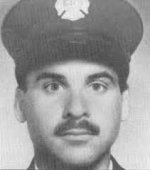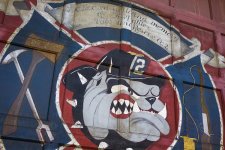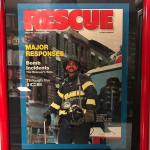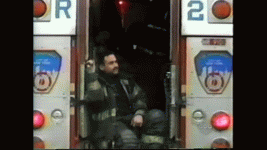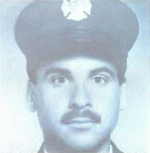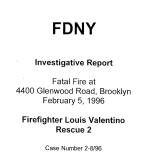
FDNY Investigative Report Fatal Fire at 4400 Glenwood Road, Brooklyn
February 5, 1996
Firefighter Louis Valentino
Rescue 2
Case Number 2-8/96
SUMMARY
On February 5J 1996 at 3:37 PM the New York City Fire Department J Brooklyn Borough Communications Office J received a telephone alarm of fire. The caller reported smoke from the roof of 4400 Glenwood Road. Units of The New York City Fire Department were dispatched. The officer of the first engine company to arrive ( Engine 310 ) transmitted a signal 10-75 ( notificatIon of a fire )J via the department radio. Smoke was issuing from a one story commercial building located behind a large gymnasium building at 4400 Glenwood Road. Fire Department operations were initiated.
Engine companies stretched hose lines into the fire building via the doors. Ladder companies forced the doors open and entered the building to search for victims and assist the engine companies. Rescue Company 2 entered the fire building to search for victims who may have been trapped inside. Conditions had improved considerably.
Suddenly with no warningJ the right side portion of the roof collapsed to ground level. Fire fighters were struck and injured by the falling roof. A roll call was conducted to account for all members. A Search For trapped or injured members was initiated. Fire Fighter Louis Valentino was discovered lying on his back. A roof beam was resting on his chest. His removal required an organized rescue effort utilizing cutting and extrication tools and equipment.
He was extricated in a timely manner. First aid was rendered immediately by fire fighters and New York City emergency medical service personnel. Fire Fighter Valentino was transported to Kings County Hospital Where he expired on February 5J 1996 ..
1541 Hrs. 1541:03 Engines 309~ 248~ Battalion 33 and Rescue 2 are dispatched in response to the 10-75.
1541:15 Ladder 157 arrives at scene.
1541:19 Dispatcher receives a telephone alarm for Glenwood Road and Troy Avenue reporting a fire in an office building. Dispatcher determines it is for the same fire.
1541:26 Dispatcher receives a a telephone alarm for a fire in a health spa. Box 3940 is designated due to the location from which the alarm originated. The dispatcher determines it was for the same fire.
1541:30 Engine 310 starts to stretch a 2 1/2u hose line to the fire building and moves apparatus to hydrant in front of the health club and connects to it. The officer of Ladder 157 contacts the officer of Engine 310 to determine the location of the fire,and along with the forcible entry team walks up the driveway to the fire building.
1541:35 Dispatcher receives a telephone alarm reporting a fire in a factory. Box 3940 is designated and dispatcher determines it is for the same fire.
1541:54 Division 7 is assigned. 1542 Hrs. 1542 Engine 255 arrives at the driveway and assists Engine 310 stretch their hose line. The chauffeur of Ladder 157 positions the apparatus (tower ladder) on Glenwood Road. The outside vent man walks to Troy Ave. to search for access to the roof of exposure 3 ( the health club ). The roof man stays with the apparatus and along with the chauffeur raises tower ladder basket to the roof of exposure 3. 31
1543 Hrs.
1543:08 Ladder 174 arrives and transmits a 10-84 signal.
1543:26 Battalion 41 arrives and transmits a 10-84 signaI.(Signal 10-84 is an announcement of arrival at the scene.)
1543:28 Battalion 41 announces he is using all hands and gives a size up of the building and conditions over the department radio.
1543:30 The officer of Ladder 157 meets the officer of Engine 310 at the fire building. He observes heavy smoke and some fire through a small entrance door which is located between 2 large roll down doors. This door is open. The roll down doors are down and pad locked. He observes sparks in the area of the large roll down door to the right of the small entrance door and decides against cutting it open. Ladder 157 forcible entry team start to enter through the small door but back out. Officers of Engine 310 and Ladder 157 decide to proceed with caution after water is put onto the fire.
1543:45 Officer of Ladder 157 notifies Battalion 41 that fire is in a set back of the health club and both discuss tactics. Ladder 157 starts to force the smaller roll down door located to the left of the small door.
1543:46 Dispatcher transmits signal 10-75.
1543:50 Chief of Battalion 41 has walked up the driveway and reaches the fire building. Engine 310 is at the small entrance door with a charged line. Chief tells officer of . Engine 310 to operate from the doorway and not push in.
1543:58 Ladder 159 is dispatched.
1544 Hrs. Ladder 174 forcible entry team arrives at the fire building. Battalion 41 Chief aSSigns Ladder 174 the task of forcing open the large roll down doors. Engine 310 operates line into the small doorway. Engine 255 starts to stretch the second 2 1/2" hose line.
1544:48 Battalion 41 transmits description of conditions to dispatcher via radio.
1546:37 Battalion 41 transmits a request for a second alarm assignment to the dispatcher via department radio.
1546:54 Dispatcher transmits a second alarm. 32
1547 Hrs. 1547:03 Battalion 41 transmits progress report to dispatcher.
1547:25 Engines 323J 281J 249J 283J 284J Ladders 147, 113J Battalion 58 and Safety Battalion 2 are dispatched.
1547:31 Engine 309 arrives at the scene and transmits signal 10-84.
1548 Hrs. Engine 255 reaches fire building with line. u
1548:30 Engine 309 starts to stretch a third 2 1/2 hose line as ordered by Battalion 41.
1549 Hrs. Engine 255 gets water in line and starts to extinguish fire through the left doorway which has been cut open . .
1550 Hrs. 1550:24 Ladder 113 acknowledges it is designated the Fire Fighter Assist and Search Team (F.A.S.T.) by dispatcher. (Designated to stand by ready to assist firefighters in distress J as the need arises).
1551 Hrs. 1551:21 Division 7 requests a run down (list of units assigned on the second alarm).
1551:38 Tactical Support unit arrives and transmits a signal 10-84.
1551:56 Rescue Company 2 arrives and transmits a 10-84 ..
1552 Hrs.
1552:30 Engine 309 reaches the fire building with their hose line. 33 1553 Hrs. Division 7 arrives and contacts Battalion 41 via handie talkie and tells him he is at the box location. Engine Company 248 arrives. Ladder 159 arrives and is directed to set up the tower ladder on Troy Avenue. 1553:39 Engine 283 arrives J transmits signal 10-84J reports into command post and stands fast.
1554 Hrs. Battalion 41 directs Rescue Company 2 to check the conditions of the fire building and exposure number 4. ( The building to the right of the fire building. ) Rescue 2 Officer directs the 2 members of their above the fire teamJ including Firefighter ValentinoJ to examine conditions of exposure 4. Rescue 2 Officer along with remaining members enters the fire building to search and clear a path for engine company to advance. Engine Company 248 starts to stretch a 2 1/2" hose line. Battalion 58 arrives and transmits signal 10-84. Battalion 58 was designated the communications coordinator by the dispatcher.
1554:06 Division 7 requests any available C.I.D.S information from the dispatcher. ( C.I.D.S. is the abbreviation for Critical Information Dispatch System which stores in it's computer critical information about specific buildings. Investigation revealed non existed.)
1555 Hrs. Firefighter Valentino enters exposure 4. ( Health club ). Engine Company 248 is stretching their hose line through the health club door located on Glenwood Road and out a back door to the fire building.
1555:09 Battalion 33 arrives J transmits signal 10-84 and reports to Battalion 41 in front of the fire building. Battalion 41 orders him to direct operations in the exposure 4 ( right side) portion of the fire building.
1555:58 Engine Company 281 arrives and transmits signal 10-84. They assist Engine Company 248 stretch their hose line. 34
1556: Hrs. Engine 310 moves their hose line from the small doorway to the right doorway and advances approximately 10 feet into the building to extinguish fire.
1556:09 Ladder 147 arrives and transmits signal 10-84. Chauffeur raises aerial to the roof of exposure 4. Remainder of company stands fast at the command post.
1556:42 Division 7 requests an additional tower ladder.
1557: Hrs. Engine Company 323 arrives.Battalion 58 directs them to stand fast. Firefighter Valentino returns from the health club~ dons his mask and enters the fire building behind Engine 310.
1557:30 Battalion 41 Chief enters the fire building through the left doorway to evaluate conditions.
1557:29 Ladder Company 120 is assigned.
1557:52 Ladder Company 113 arrives~ transmits signal 10-84J and stands fast as the Firefighter Assist and Search Team.
1558:Hrs. Engine Company 249 arrives and is directed by Battalion 58 to stand fast at command post. Engine 248 connects their hose line to Engine 310's pumper J receives water and advances into the fire building through the right doorway.
1600:Hrs. The fire is largely extinguished with the remaInIng fire confined to the ceiling and the 11 vehicles contained within the building. Engine 255 enters the fire building· through the left doorway to extinguish remaining pockets of fire. Battalion 41 Chief tells them to use a light spray to prevent dislodging anything. 35
1601:Hrs. Engine 309 is operating their line into building from the left doorway toward the left (exposure 2) wall. Engine 255 briefly operates line to extinguish fire in the ceiling toward the right (exposure 4) side approximately 10 feet from the doorway.
1601:05 Engine 310 operates their line toward the front in the middle of the ceiling from approximately 10 feet inside the fire building.
1601:10 Engine 248 has advanced their line approximately 20 feet into the fire building through the right doorway. They open the nozzle to extinguish fIre in a burning vehicle directing the stream toward the front of the building.
1601:18 Engine 310 shuts down their nozzle.
1601:20 The roof of the fire building~ collapses.
1601:25 The first of several MAY DAY S are transmitted via handie talkies. Firefighters in-side the building are struck by falling roof and masonry material. Some are injured. Most are disoriented. Some find their way out Others require assistance which is provided by firefighters in the immediate vicinity. Battalion 58 assigns Ladder 113 and Ladder 147 to assist. Engine 249 is directed to back up Engine 310.
1602:Hrs. Engine 281 operates Engine 255's hose line to prevent fire from reaching possible trapped firefighters. . . Division 7 calls Battalion 58 to the fire building. He informs him of the collapse and directs him to conduct a roll call. He instructs Battalion 33 to coordinate the extrication of trapped members. 36
1603:Hrs First roll call is conducted by Battalion 58. All units report all members accounted for with the exception of one member of Rescue 2. Ladder 159 joins rescue effort and brings tools to scene.
1603:30 Firefighter Louis Valentino is discovered face up approximately 15 feet from the right side doorway midway between the left and right walls. A wooden roof beam is resting on his chest. The beam is still fastened to the roof which is largely intact at this location. Firefighters first to assist try to lift the beam and attached roofing material manually. Their efforts fail.
1604 Hrs. Battalion 58 assists in organizin9 the rescue effort. Organized extrication efforts begln. It becomes obvious that much cutting and mechanical lifting of the roof will be required. Rescue 2, Ladder 113 and Ladder 147 work together to stabilize, cut and lift the beam and roof from Firefighter Valentino. Saws, air bags, hand tools and blocking material were brought to the scene and utilized.
1605 Hrs.
1605:30 The Chauffeur of Engine 255 contacts Fire Department Dispatcher via radio, requests E.M.S. and reports a collapse and injured members.
1605:49 The Chauffeur of Engine 255 contacts Dispatcher and reports Engine 255 is not effected. Chief of Battalion 41 and members of Ladder 157 and operating units were under collapse. We are trying to pull them out now.
1606 Hrs.
1606:30 battalion 58 conducts a second roll call. The results duplicate the original.
1606:34 Engine 284 arrives and transmits signal 10-84. They walk to the fire building, find many units already there and return to street where they clear street for E.M.S. vehicles. 37
1607 Hrs. 1607:09 Rescue 4 is assigned.
1607:43 Safety Battalion 2 arrives and transmits signal 10-84
1608 Hrs. Safety Battalion Chief evaluates conditions, the ongoing extrication effort and fire fighting operation. He orders a complete face to face roll call. All members not participating are directed to leave the immediate area. Operations are closely monitored.
1609 Hrs.
1609:13 Battalion 58 contacts dispatcher and requests a third alarm, the collapse unit and E.M.S.
1609:21 Fire Department Dispatcher transmits a third alarm.
1610 Hrs.
1610:21 car 10 D notifies dispatcher he is responding to the third alarm.
1610:37 Ladder 120 arrives and transmits a signal 10-84
1611 Hrs. 1611:21 Rescue 4 notifies dispatcher they are responding to the third alarm.
1614 Hrs.
1614:41 Division 7 contacts dispatcher and reports still trying to extricate one member and asks for a mixer off message. Division 7 reports to dispatcher all members have been accounted for except for one member from Rescue 2 who is still trapped. . 38
1615 Hrs. Firefighter Valentino is extricated and first aid is administered. First aid is continued as he is placed into a Stokes basket and carried to the ambulance waiting in the street.
1615:30 Division 7 contacts dispatcher and reports they have their hands on him so it looks like they are going to get him.
1618 Hrs. Firefighter Valentino is placed into the ambulance and transported to hospital. 39
CAUSES DIRECT
Firefighter Valentino was operating in a hazardous position inside the fire building. Autopsy report lists cause of death as compression of chest. Failure of the columns and roof structure of the fire building caused a wood roof joist to fall onto the chest of Firefighter Valentino. INDIRECT Delayed transmission of alarm. Gasoline leaked from a severed fuel line. Acetylene leaked from a failed tank. Leaking gasoline and acetylene gas fed the fire causing unusually high temperatures to be reached. The heat caused the failure of the columns which supported the roof structure. 45 EARLY The fire building was an illegal structure that did not meet the requirements of building or fire department rules and regulations. The owner of the building foiled to comply with rules and regulations applicable to the building. The buildings occupants engaged in illegal and unregulated hazardous activities. Agencies having jurisdiction foiled to detect J inspect and enforce rules and regulations applicable to the building and occupancy. 46
RECOMMENDATIONS
Establish an inspection program to seek out buildings for which there are no records. All agencies with jurisdiction to be immediately notified for proper corrective action. As they are detected, Qualifying buildings shall be the subject of priority C.I.D.S. reports identifying and describing them. Where access can not be obtained the C.I.D.S. card sholl state. UConstruction, occupancy and contents unknown u , It is probable that many of these buildings will be in locations not readily seen. A list of all designated buildings should be made available to responding units for advance knowledge and familiarization. Drills specific to the building to. familiarize and emphasize proper tactics and procedures should be conducted as soon after detection as possible. During the course of Apparatus Field Inspection Duty emphasis should be placed on detecting Questionable construction methods and/or building materiols. As they are discovered, specially trained inspectors should perform a follow up inspection and the appropriate action taken. Tactics and procedures specifically tailored to such buildings should be incorporated into the fire fighting manuals. Fire fighting manuals should place more emphasis on the fact that roof ventilation is not always necessary. Whenever roof operations are not required, all personal should be notified. Members assigned roof positions should be utilized for other tasks. If roof operations are suspended because the structural stability of a roof is in doubt, operations on and beneath should cease and all members withdrawn and accounted for immediatly. In situations where tower ladders or deck pipes can not be positioned for use of their large caliber streams6 greater consideration should be given to the use of porta Ie large caliber streams in place of hand operated hose lines. Their early use in appropriate situations would reduce the number of members operating in hazardous locations. 47 An advanced fire in any building must be treated with extreme caution. An advanced fire in a building of undetermined construction and/or occupancy presents on even greater hazard.Unless there is reason to believe there are occupants withinJ entry into or onto such buildings should not be the standard operating procedure. Only after a thorough and deliberate evaluation is conducted should entry be made and then only by the minimum number of personnel required. Tactics and procedures manuals should be revisited. An attempt should be made to identify specific conditions in specific buildings and/or occupancies which mandate withdrawal of personnel pending a period of observation and evaluation. Before recommitting personnel J specified units with predetermined tasks must be designated. During this hi~hly organized deliberate stage of the operationJ dedlcated direct communication with all committed members must be established and verified. All other personnel must be instructed to refrain from transmitting Handie Talkie messages except in emergencies. The exact location and actions of all personnel should be monitored and strictly controlled by the incident commander. I . A F.A,S.T. unit must be in place~ equipped and aware of the committed units location and assignments ot all times. Members not actively enga~ed should be removed to a . specificJ dedicated locatlon. To ensure complianceJ a chief officer should be assigned the task of monitoring the location and actions of all unassigned personnel. The time required to conduct a roll call would be reduced. Rescue efforts could be rapidly directed to the specific personnel in distress. Constant trainingJ drilling and enforcement of this principle as a standard procedure would reduce if not prevent the tendency to advance into and 5tay in potentially hazardous locations after assignments are completer. Assign earlier response of the safety operating battalions to fires or emergencies in buildings containing unusual hazards or collapse potential. Such buildings can be easily identified from C.l.D.S. files or other sources. The timely arrival of a specially trained chief officer whose primary concern and function is the safety of operating members and who can devote his fUll attention to this task J will provide invaluable assistance and expertise to the inCident commander. 48 The incident commander and all other members arrive on the scene with a mind-set directed toward aggressively searching for occupants and fighting the fire as rapidly I as possible. ~ They have many factors to consider in a rapidly developing situation in an unfamiliar location. All too often fire fighting and safety are not considered simultaneously. I Early input from the safety chief before personnel are I committed and exposed to undetected and/or unanticipated I hazards can prevent future tragedies. Establish a training program dedicated to the collapse potential of structures with particular emphasis placed on commercial buildings. It should be a high impact J graphic demonstration. Slides and video tapes illustrating actual collapsed structures coupled with examples of existing shoddy construction methods and materials should be emphasized. They should highlight the weakened state of buildings after they have been exposed to fire conditions. Special emphasis should be placed on the effects fire fighting and overhauling can have on the stability of the various structural members of a building. The goal should be to prevent the complacency and false sense of security that often develops as fire fighting operations in structures of this type become routine. At the training center erect a demonstration building constructed of buildingJ components that have been previously exposed to fire conditions. As an example~ sagging steel~ burned through beams or cracked masonry. If artificially reinforced~ it can be made to appear realistic and as though an actual fire had taken place. Conduct familiarization and fire fighting training sessions within. Use artificial smoke and the absence of li~ht to demonstrate how extremely hazar,jous conditIons can be impossible to detect until the area is adequately ventilated and illuminated. Provide illumination of and signs pOinting to the fire weakened structural" elements~ unstable support points. Describe the effects hose streams and overhauling practices might have on each of them. Incorporate displays and photographs that illustrate the interdependence of various building components and how the failure of one can effect others and ultimately the entire structure. 49 If a site or funds for construction of a demonstration building are not immediatly availableJ incorporating such structural elements into an existing building and using them in conjunction with displays and photographs would be a good beginning.
